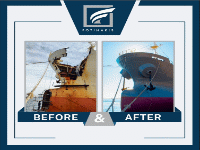By Nick Blenkey, Senior Editorial Consultant With U.S. offshore wind development being put on an indefinite pause, the offshore wind support vessel market outlook for U.S. operators and builders looks to be

Island Offshore is building two energy support vessels at Fincantieri’s Norwegian-headquartered Vard subsidiary. (Credit: Island Offshore)
By Nick Blenkey, Senior Editorial Consultant
With U.S. offshore wind development being put on an indefinite pause, the offshore wind support vessel market outlook for U.S. operators and builders looks to be dismal for the immediate future. For shipyards in particular, offshore wind vessels looked like they could fill some of the void left when the bottom dropped out of the newbuild Jones Act offshore oil and gas vessel business—and, for that matter, the worldwide market for platform supply vessels.
With a White House that’s all in on “drill, baby drill,” there are hopes that Jones Act offshore vessel prospects could be lifted by a boom in U.S. offshore oil and gas exploration and production. Meantime, as this was written, the industry was still stuck with a 2024 to 2029 oil and gas leasing program that only schedules three oil and gas lease sales in the U.S. Gulf in 2025, 2027 and 2029—the fewest oil and gas lease sales in history.
Elsewhere in the world, there are plenty of places where offshore oil and gas exploration and production is alive and well. That includes Brazil, where orders for newbuild PSVs (platform supply vessels), the workhorses of the oil patch, are starting to happen.
Last December, Edison Chouest Offshore’s Brazilian affiliate Bram Offshore was one of two companies that will each build and operate six new hybrid PSVs under contracts awarded by Brazilian energy major Petrobras. The other company is Starnav Serviços Marítimos, a subsidiary of Brazil’s Detroit Group.
The contracts were announced by Petrobras President Magda Chambriard. Worth a total of BRL16.5 billion (about USD 2.75 billion) they cover the construction and chartering of 12 hybrid PSVs). Of the total value of the contracts, BRL 5.2 billion (about USD 862 million) is earmarked for investments in shipbuilding in Brazil.
The Petrobras contracts include a period of up to four years for mobilization and 12 years of operation and include a requirement of 40% local content during the construction phase. The vessels will be built in the winning companies’ own shipyards, located in Santa Catarina, in the cities of Navegantes (Bram) and Itajaí (Starnav). Each company will be responsible for chartering six vessels for Petrobras.
That news came after Evangelos Marinakis’ Capital Offshore is changing things up, including by placing an order with China’s Fujian Mawei Shipbuilding for 10 PSVs of MMC 897 CD design from Gdynia, Poland-based MMC Ship Design. That order was placed with Brazil being seen as the potential market.
And that’s good news for Kongsberg Maritime. It has received a NOK 800 million (about $73 million) order from the shipbuilder to supply an extensive range of equipment for the vessels that includes all propulsion, automation, and energy systems.
The 10 contracted vessels mark a major investment by Capital Offshore in the PSV market. The company, which owns and operates significant tonnage with a fleet of more than 100 vessels, has a strategic goal to expand in offshore oil and gas operations. These new vessels are intended for the Brazilian market.
The order was good news for Norway’s Kongsberg Maritime which received a NOK 800 million (about $73 million) order from the shipbuilder to supply an extensive range of equipment for the vessels that includes all propulsion, automation, and energy system
Kongsberg is one of a host of Norwegian companies on the cutting edge of offshore service vessel design, equipment and, to a lesser extent, construction. That has certainly been the case for offshore wind vessels, but a recent trend has been to look at designs that can work in both offshore wind and the oil and gas sector.
That trend has seen Norway’s Sea1 Offshore (the former Siem Offshore) double down on a two-ship order placed in November last year, by now placing an order at Chinese shipbuilder Cosco Shipping (Qidong) Offshore Co. Ltd. for two more high-end ST-245 design offshore energy support vessels.
Based on the Skipsteknisk ST-245 design they will have capabilities to serve both oil & gas and renewable markets and Sea1 says they will be equipped with some of the most fuel-efficient solutions in the market. Generators, battery packages and thruster configuration are fine-tuned and include the latest technology available. The vessels are methanol ready, and the generators can run on 100% biofuel.
Skipsteknisk says that this is a new version of the ST-245 design that has been developed to the meet the specifications set by the market and by Sea1 Offshore.
The vessels will be 120 meters in length, featuring a spacious open deck of 1,400 square meters and accommodations for up to 120 people. They will be equipped with a 250-ton subsea crane and two integrated WROV hangars with side-launch capability. The designs are also prepared for the future installation of an offshore gangway, making them suitable for offshore wind operations.
The ST-245 designs will be equipped with modern technology to reduce emissions and maximize operational efficiency. They are methanol-ready, and the generators can operate on 100% biofuel, offering a flexibility that customers will appreciate
The ST-245 vessels will mainly be used for commissioning and recycling work, support for the energy industry, and subsea operations.
The trend for vessels that can operate in both the renewables sector and in the offshore oil and gas market has brought Kongsberg Maritime a contract for the design of two UT7623 SEV design multipurpose subsea vessels for Fosnavåg, Norway-headquartered Olympic Group.
The vessels will be constructed at the CMHI shipyard in Shenzhen, China, with delivery scheduled for the summer of 2027. They will operate in both the renewable energy and oil and gas sectors, featuring advanced technologies that significantly exceed the requirements of the Paris Agreement.
Fincantieri’s Norwegian subsidiary Vard now has two 120-meter ocean energy construction vessels on order for the Chouest and Ulstein families’ Island Offshore that are being built to a new Vard 3 25 design, developed for the offshore energy industry’s transition from oil and gas to renewables.
The vessels will carry out subsea operations including IMR (inspection, maintenance, and repair), pipe laying, subsea infrastructure construction and installation, diving support, and equipment for remotely operated underwater inspection. They will also be prepared for renewable work scopes such as walk-to-work, commissioning, cable laying and repairs, trenching and survey. The design is prepared for installation of a gangway system features a heave compensated offshore subsea crane of 250 tons.
Offshore wind farms are currently serviced using crew transfer vessels (CTVs) or helicopters for day operations, and service operation vessels (SOVs) for extended periods. Aiming to reduce costs, Norwegian designer Ulstein has developed the SX250, described as a CAPEX-smart design that reduces building costs by over 50% compared to an SOV and supplement the SOVs on most tasks.
SOVs are the most efficient and preferred solution today for servicing offshore wind turbines, outperforming CTVs in safety, availability, and comfort. However, rising shipbuilding costs and newbuild delivery times threaten their viability, says Ulstein. CTVs, on the other hand, face tougher requirements, such as slower speed in protected areas and reduced emissions.
In designing its new SX250, Ulstein’s team aimed to develop a walk-to-work vessel that reduces vessel CAPEX by at least 50% compared to an SOV, reducing OPEX accordingly, while retaining most of the key functionalities and operability.
The Ulstein SX250 aims bridge the gap between CTVs and SOVs, introducing new service logistics. One or more SX250 vessels can support a full-sized SOV, the latter handling larger tasks while two to three SX250 vessels manage the smaller jobs. This setup meets service requirements and maintains the necessary up-time and it allows for more detailed operational planning and distribution of workload. The Ulstein SX250 design is best suited as the preferred solution for small and medium-sized windfarms, windfarms located in areas with benign and moderate sea states, or in shallow waters. The SX250 is also, says Ulstein a perfect supplement to cater for the additional maintenance activities typically carried out during the summer campaigns.
Content Original Link:
" target="_blank">




















































